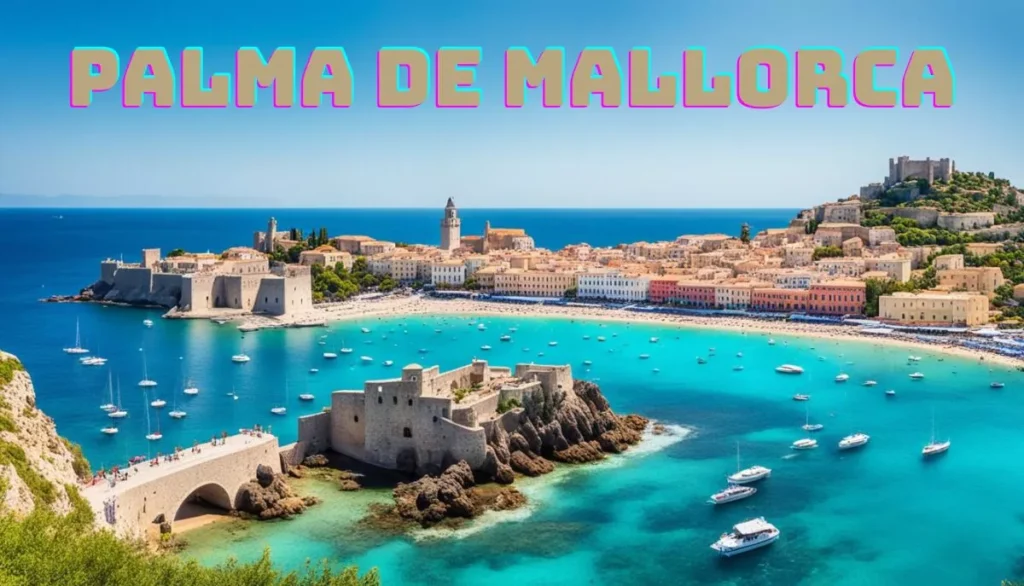What’s your idea of a perfect vacation? For some, it’s the sunny Caribbean; for others, it’s snowy Alaska. But have you considered Palma de Mallorca, Spain, a beautiful Mediterranean jewel?
My quest to find Palma de Mallorca’s best spots was a journey of discovery. The city is both rich in history and stunning natural beauty.
Picture this: relaxing indoors while enjoying beautiful views. It’s like the cozy Cafe @ Two70 on Quantum of the Seas.
But here, you’re surrounded by the charm of Palma de Mallorca. The place offers a mix of history, culture, and nature. It’s all laid out for you to enjoy.
Note from the author: I must confess that I did not visit everything written below due to time, but I found it worth mentioning so that you are better informed of everything you can do.
Introduction to Palma de Mallorca
Discovering Palma de Mallorca is like finding a treasure chest. It’s packed with history, culture, and natural beauty. Unlike the busy and loud setting of most cruise stops, Palma offers calm and structured sightseeing. This makes it perfect for a peaceful vacation in Spain.
Being a true Mediterranean paradise, Palma de Mallorca enchants with its mix of old charm and modern life. Walk busy old streets or relax by the blue sea. This Palma de Mallorca guide will lead you to its best spots.
Food in Palma is more than eating, it’s an adventure. Try Spanish tapas in cozy cafes or find gourmet food in elegant spots. All this with a view of stunning historic sites and nature.
Everywhere you go in Palma de Mallorca, you find beauty. From grand cathedrals to clear beaches, it’s a place that invites you to relax and explore. It promises a mix of rest and excitement, turning each day into a memorable one.
Historical Significance and Heritage Sites
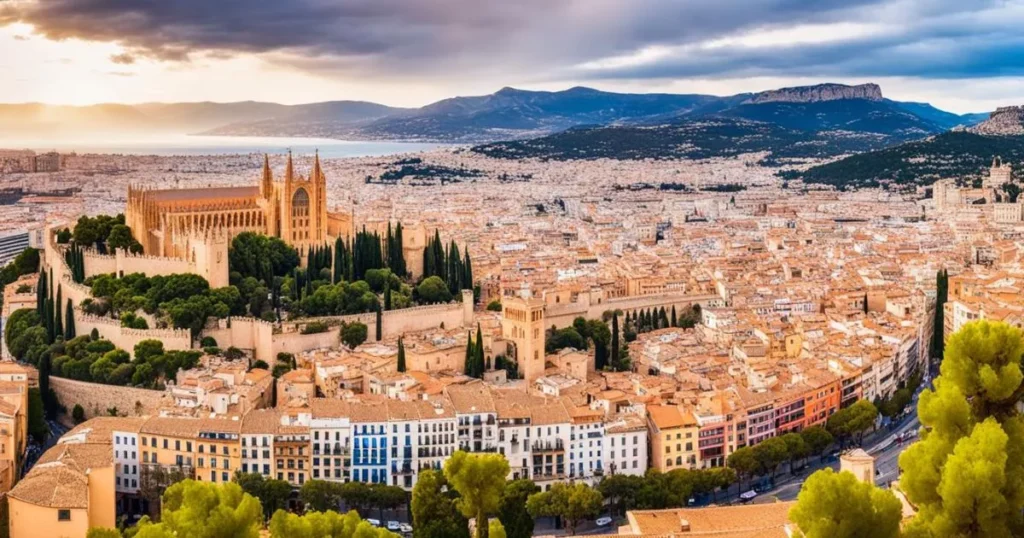
The historical significance of Palma de Mallorca is held within its rich culture. This culture is shown in its beautiful heritage sites. The island tells stories of its past. It has influences from Roman, Moorish, and Christian cultures. Each of them left an indelible mark on its architecture and culture.
One of the most iconic landmarks is La Seu, the majestic Gothic cathedral that dominates the city’s skyline. Built on the site of a former mosque, it stands as a symbol of the Christian reconquest and offers breathtaking views of the Mediterranean Sea.
Another architectural marvel is the Royal Palace of La Almudaina. It was originally an Arabian fort and is now the Spanish Royal Family’s summer home.
The old town has narrow, winding streets. They are lined with well-preserved medieval buildings, charming courtyards, and historic churches. One example is the Basilica of Sant Francesc. The Arab Baths, one of the few remnants of Palma’s Moorish past, provide a glimpse into the daily life and sophisticated engineering of the Moors.
These heritage sites, among many others, make Palma de Mallorca a living museum. Every corner there whispers tales of past eras. It gives visitors a chance to dive into its history.
Exploring Ancient Rome’s Influences
Spain’s connection to ancient Rome is strong in Palma de Mallorca. This is seen in its amazing buildings and ancient objects. Walking the city’s streets, you can see how Roman engineering and planning shaped the island’s look.
Palma was originally founded as the Roman camp of Palmeria. Its Roman heritage is clear in its old buildings and city layout. The grid-like layout of the old town reflects Roman urban planning principles. The remnants of ancient roads and aqueducts showcase their engineering skill.
Nearby archaeological sites, like the ruins of Pollentia, give more insights into Roman life on the island. They display artifacts such as pottery, coins, and mosaics in the Mallorca Museum.
These relics show the daily life and culture of Roman settlers. They also highlight their influence on the island’s later development. Roman law, governance, and art left a lasting impact on Palma. It’s woven into the city’s culture and institutions. It offers an enthralling journey through time for both history buffs and casual visitors.
The Majestic Almudaina Palace
The Almudaina Palace speaks of the island’s medieval times. This grand building shows the mix of different cultures and periods. As a top heritage site in Palma de Mallorca, it offers a deep view of the island’s past.
It was originally an Arabian fortress. The Christian reconquest transformed it into a royal residence. It blends Islamic and Gothic styles into a harmonious fusion. The palace overlooks the calm waters of the Mediterranean. It stands as a symbol of Palma’s strategic and cultural importance over the centuries.
The palace’s courtyard has lush gardens and tranquil fountains. It offers a peaceful retreat amid the grandeur. Today, the Almudaina Palace is the official summer residence of the Spanish Royal Family. But, it is also open to the public. Inside, visitors are greeted with opulent halls. They are adorned with tapestries and antiques that reflect their royal heritage.
Each room and corridor of the Almudaina whispers stories of the past. It is a must-visit for anyone intrigued by Palma de Mallorca’s royal and multicultural history.

The Gothic Architecture of La Seu
Palma’s stunning La Seu Cathedral is a Gothic masterpiece. Its tall structure highlights the great art and building skills of the past. La Seu dominates Palma de Mallorca’s skyline. It stands proudly on a former mosque’s site, symbolizing the island’s Christian reconquest.
It was constructed over several centuries, starting in the 13th century. The cathedral’s design shows the grandeur and verticality of Gothic architecture. Its outside has tall spires and detailed stone carvings. The inside is lit by ethereal light through some of the world’s largest and most intricate rose windows.
The cathedral has soaring ribbed vaults, pointed arches, and slender columns. They draw the eyes upward. They create an awe-inspiring space that uplifts the spirit. The famous architect Antoni Gaudí helped restore it in the early 20th century. He added a unique mix of modern elements while respecting its Gothic essence.
La Seu is majestic. It is both a place of worship and an architectural masterpiece. It is a key part of the island’s history and is known for its beautiful details and interiors. Anyone who loves Gothic architecture must see this cathedral.
The Arab Baths
The Arab Baths in Palma de Mallorca, known as “Banys Arabs,” are a captivating relic of the island’s Moorish past, dating back to the 10th century.
The baths are in a quiet corner of the city’s old quarter. They offer a rare glimpse into the Moors’ sophisticated city life and clever architecture. The well-preserved remains feature a central room with a large dome. The dome has star-shaped vents. The vents let light through, creating a peaceful and mystical feel.
Surrounding this central area are smaller rooms that once served as changing areas and cold baths. The columns and arches were repurposed from earlier Roman buildings. They show a blend of artistic and cultural influences. The tranquil garden is outside the baths. It is filled with lush greenery and ancient stonework.
The garden provides a peaceful place for contemplation. Visiting the Arab Baths is like stepping back in time. They offer an intimate look at the daily life and advanced engineering of medieval Islamic society in Palma de Mallorca.
The Basilica of Sant Francesc
The Basilica of Sant Francesc is a stunning example of Gothic architecture and a symbol of the city’s religious and cultural heritage. It was built in the 13th century. The basilica is dedicated to Saint Francis of Assisi.
It shows the historical importance of the Franciscan order on the island. The facade is impressive. It is adorned with a large rose window and intricate carvings. It invites visitors into a world of spiritual and artistic splendor.
Inside, the basilica has a beautiful nave. It has soaring arches and ornate chapels. It also has an exquisite baroque altarpiece. The tranquil cloister is a highlight of the complex. It offers a serene environment with a lush garden and elegant arcades.
It is perfect for quiet reflection. The tomb of the famous philosopher and theologian Ramon Llull is a notable feature. It adds an intellectual and historical dimension to the basilica’s spiritual feel. The Basilica of Sant Francesc is a place of worship and a cultural landmark, preserving centuries of history and art within its sacred walls.
The Enchanting Beaches and Coastal Areas
Exploring the beaches of Palma de Mallorca lets you see a wide range of landscapes. It has a perfect mix of natural beauty and lively seaside culture. This makes the island a top spot for sun-seekers and adventure fans. Palma stretches along the stunning Mediterranean coast.
It boasts some of the most picturesque beaches in the Balearic Islands. Playa de Palma has golden sands and clear turquoise waters. It is a favorite for both relaxation and water sports. For a more secluded experience, Cala Major offers a tranquil escape. It has a cozy cove and serene feel.
The coastline has many charming fishing villages, upscale marinas, and scenic promenades. Each has breathtaking views of the sea. The clear waters are ideal for snorkeling, diving, and sailing. They let visitors explore lively marine life and underwater landscapes.
You can lounge under the sun. You can enjoy a seaside meal at one of the many beachfront restaurants. Or, you can explore the dramatic cliffs and hidden bays. The beaches and coastal areas of Palma de Mallorca captivate with their charm and diverse fun.
Most beaches in Mallorca are ideal for children. They are safe, easily accessible, and surrounded by Mediterranean beauty. The calm, shallow waters make them perfect for families. They create a peaceful and fun seaside experience.
Relaxing at the Bay of Palma
Relaxing at the Bay of Palma in Palma de Mallorca is serene. It combines beauty with vibrant Mediterranean life. You can enjoy the sea’s shimmer or walk along the coast. The bay is framed by the city’s historic skyline and the sparkling blue sea. It offers a picturesque setting, great for unwinding and soaking in the island’s charm.
The promenade is scenic and known as Paseo Marítimo. Visitors can stroll, cycle, or sit and watch the world go by there. They can enjoy views of luxurious yachts and traditional fishing boats bobbing in the harbor.
The area has lively cafes, gourmet restaurants, and stylish bars. At these places, you can savor local delicacies and refreshing drinks. The gentle sea breeze and the rhythmic waves create a soothing ambiance. It is ideal for relaxation.
Nearby, The Parc de la Mar provides a peaceful green space with shady spots perfect for picnics and leisurely afternoons. You can bask in the sun, dine on the waterfront, or explore the cultural sights that line the bay. These include the iconic La Seu cathedral. Relaxing at the Bay of Palma offers a perfect mix of peace and vibrant coastal charm.
Peaceful Cala Major Beach
Cala Major is nestled along the southwestern coast of Palma de Mallorca. It is a picturesque beach known for its peace and beauty. With its soft golden sand and clear turquoise waters, Cala Major offers a serene escape from the bustling city life.
The beach is sheltered by surrounding cliffs, creating a secluded cove that feels like a hidden gem. Families and sun-seekers flock to Cala Major to bask in the Mediterranean sun, swim in the calm, shallow waters, or unwind on the shore.
The beach has many amenities. These include sun loungers, umbrellas, and beachfront cafes. They serve refreshing drinks and delicious seafood. Cala Major also has great water sports facilities.
They make it a popular spot for paddleboarding, kayaking, and snorkeling. You might seek a relaxing day by the sea or an active adventure on the water. Cala Major offers the perfect mix of beauty and fun for visitors to Palma de Mallorca.
Vibrant Can Pere Antoni Beach
Can Pere Antoni is a vibrant and inviting beach. It’s close to the heart of Palma de Mallorca. It offers the perfect mix of city convenience and seaside relaxation. The beach stretches along the scenic coastline just east of the city’s historic center.
It has soft golden sands and clear blue waters. Locals and tourists both love it. Its nearness to the city means that visitors can easily access many amenities. These include beachfront bars, cafes, and restaurants. There, they can enjoy tasty local food and refreshing drinks.
The beach is also well-maintained and has facilities. These include showers, sun loungers, and umbrellas. They ensure a comfy and fun time for all. The beach is popular among families and young people.
This is thanks to its lively feel and the stunning view of Palma’s iconic La Seu Cathedral. You can sunbathe, swim, or take a stroll. Can Pere Antoni is a delightful coastal escape in the vibrant city of Palma de Mallorca.
Vibrant Nightlife and Entertainment Options
As the sun sets, Palma de Mallorca comes alive with energy, transforming into a hotspot for both locals and tourists.
Palma de Mallorca’s nightlife and entertainment are vibrant. They offer an exhilarating mix of experiences. They cater to a wide range of tastes and preferences.
The trendy Santa Catalina district is a hub of activity. It’s known for its stylish bars, chic lounges, and lively clubs. At these clubs, music and laughter spill into the streets.
Paseo Marítimo, the scenic waterfront promenade, boasts an array of nightclubs and beach clubs that feature top DJs and dancing until dawn. For a more relaxed evening, visitors can enjoy a cocktail at one of the many rooftop bars. For example, Sky Bars offers stunning views of the lit-up Palma Cathedral and the bay.
Culture lovers can indulge in a night at the Teatro Principal. They can catch a show of opera, ballet, or modern theater. Also, the city’s tapas bars, and late-night eateries create the perfect setting. You can savor delicious local food and socialize there.
It has sophisticated jazz clubs and bustling night markets. Palma de Mallorca’s nightlife is a vibrant tapestry of entertainment. It promises unforgettable evenings.
Delicious Culinary Experiences
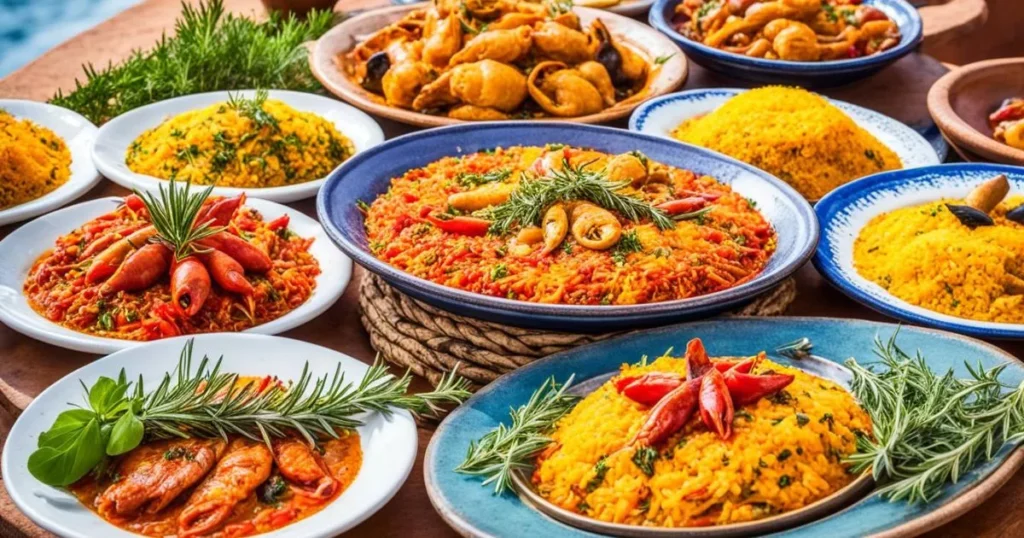
Palma de Mallorca is a food paradise. It offers a rich tapestry of flavors and dining experiences. They reflect its diverse culture and lively Mediterranean setting.
The city’s food scene has traditional tapas bars and bustling markets. It also has upscale restaurants run by famous chefs. Local specialties like “sobrasada” (a cured sausage) and “ensaimada” (a sweet pastry) introduce you to Mallorcan cuisine. Fresh seafood dishes, like paella and grilled octopus, show off the island’s maritime bounty.
The lively Mercat de l’Olivar is a must-visit. Visitors can savor fresh produce, artisanal cheeses, and regional treats. Palma de Mallorca’s dining scene embraces innovative fusion cuisine. It blends local ingredients with international influences to create unique dishes.
The waterfront and old town are picturesque. They are the perfect backdrop for alfresco dining. There, you can enjoy meals with local wines or refreshing sangria. You can enjoy a gourmet tasting menu or simple, rustic dishes in Palma de Mallorca. The food there will tantalize your taste buds and leave lasting memories.
Best Restaurants in Palma de Mallorca
Palma de Mallorca has a diverse dining scene. Some of the best restaurants offer a mix of traditional Mallorcan food and innovative dishes.
At the top of the list is Marc Fosh. It’s a Michelin-starred restaurant where the British chef serves Mediterranean dishes with a modern twist. He focuses on fresh, local ingredients. Adrián Quetglas is another Michelin-starred gem. It offers an exquisite fusion of Spanish and international flavors. They craft them into beautifully presented tasting menus.
Those seeking an authentic taste of Mallorca should visit Celler Sa Premsa. It has a rustic feel and hearty local dishes like “tumbet” and “frito mallorquín.” Seafood lovers should not miss Ca’n Eduardo. It’s located by the fish market and is known for its fresh catches and stunning views of the cathedral and harbor.
You can dine on the rooftop at Es Baluard Restaurant & Lounge. It offers a unique experience with panoramic city views. They serve modern Mediterranean cuisine. These restaurants, each with its unique charm and culinary expertise, make Palma de Mallorca a true gastronomic destination.
On the other hand, if you like something cozier, the town’s tapas bars are perfect. Bar España is especially popular, showing off the island’s true vibe and flavor.
Rich Cultural and Artistic Scene
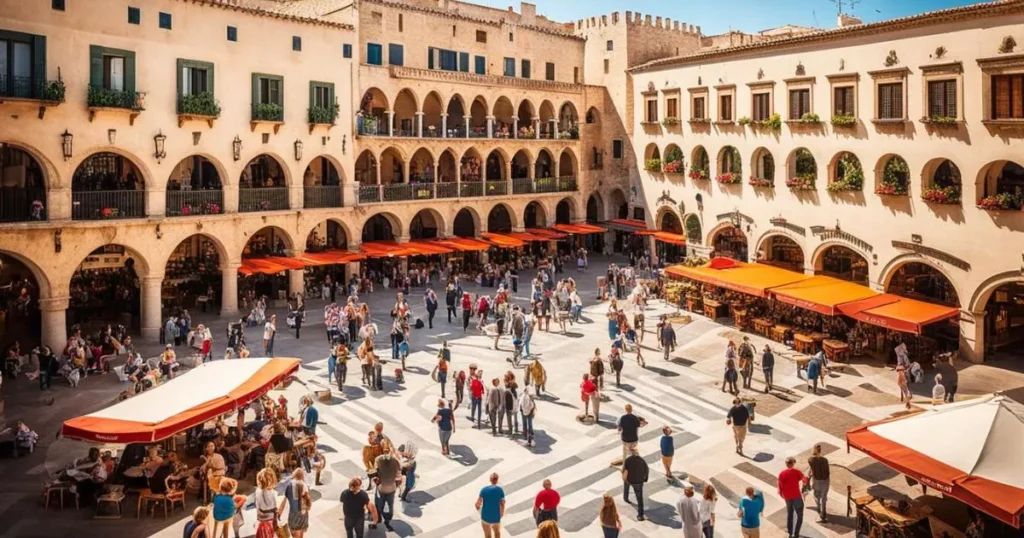
The city’s rich cultural and artistic scene is a dynamic tapestry. It reflects Palma de Mallorca’s historical depth and current vibrancy. The city’s old town has narrow streets and charming plazas. It is dotted with galleries, museums, and theaters. They showcase a diverse array of artistic expressions.
The Es Baluard Museum of Modern and Contemporary Art is housed in a 16th-century fortress. It features works by famous artists like Picasso, Miró, and Barceló. The museum combines historic and modern art. The Fundació Pilar i Joan Miró offers insight into the life and works of the famous Spanish painter who spent his later years on the island.
Palma’s cultural calendar is full of events. It has classical music concerts at the Grand Palma Cathedral and avant-garde performances at the Teatre Principal. The Teatre Principal is the oldest theater in the Balearic Islands. Street art and local crafts add vibrant colors to the city’s public spaces.
Traditional festivals like Sant Sebastià and Sant Joan bring the streets alive with music, dance, and celebration. This thriving arts and culture scene makes Palma de Mallorca a feast for the eyes. It’s also a lively and inspiring destination for both locals and visitors.
Exploring Contemporary Art at Es Baluard
Entering Es Baluard, you’ll be amazed by the avant-garde art inside. This museum is a key player in Mallorca’s cultural atmosphere, displaying artwork that challenges and intrigues. It’s a treasure trove for those interested in modern art, with interactive displays and thought-provoking pieces.
It is nestled within the historic walls of a 16th-century military fortress. Es Baluard blends the old with the new. It offers visitors a unique cultural experience. The museum has an extensive collection. It features works by famous artists such as Pablo Picasso, Joan Miró, and Miquel Barceló. It also has pieces by local talents who are just starting.
Curators at Es Baluard thoughtfully choose the exhibits. They often address themes that connect to the island’s culture and modern issues. Visitors can wander through wide, bright galleries. They showcase paintings, sculptures, photos, and multimedia. Each piece provokes thought and sparks the imagination.
The museum’s terrace offers stunning views of Palma’s Bay and the city around it. The views add to the artistic ambiance. Es Baluard hosts workshops, lectures, and interactive programs. It is not just a museum but a vibrant hub for artistic dialogue and innovation.
This makes it a must-visit for art enthusiasts exploring Palma de Mallorca.
Joan Miró Influence and Galleries
Joan Miró’s influence is all over the art scene in Palma de Mallorca. Several galleries there show his works and honor his legacy. It is in the artist’s former studio and home. The museum offers a complete collection of his paintings, sculptures, and drawings. It gives insight into his creative process and growth as an artist.
Visitors can explore the small spaces where Miró lived and worked. They will gain a deeper understanding of his strong connection to the island and its landscapes. Additionally, the Es Baluard Museum of Modern and Contemporary Art has many of Miró’s works. It further shows his impact on global art.
The galleries celebrate Miró’s modern art contributions. They also inspire art fans. The fans want to immerse themselves in his visionary world.
The Dynamic Santa Catalina Art District
The Santa Catalina district is a vibrant and creative spot in the heart of Palma de Mallorca.
The eclectic neighborhood is a haven for artists, designers, and creatives. They draw inspiration from its historic charm and contemporary energy.
The streets are colorful. They are lined with galleries, studios, and boutiques. Local artisans display their art there. It ranges from traditional paintings to avant-garde sculptures. The district has a bohemian atmosphere.
It’s enhanced by lively cafes, trendy bars, and bustling markets. Visitors can immerse themselves in the city’s food and social scene there. Santa Catalina also hosts art events, exhibitions, and festivals. They create a sense of community and collaboration among residents and visitors.
You can explore the latest gallery openings in Santa Catalina. You can also savor gourmet cuisine or simply soak in the neighborhood’s creative vibe. Santa Catalina offers an enchanting mix of culture, diversity, and artistic expression. It captivates all who wander its streets.
Easy Accessibility and Encouraging Year-Round Visits

Making a trip to Palma de Mallorca is easier than the fuss with cruises. The island is well-connected, making accessible vacations in Spain simple for global travelers. You can easily hop on a flight from many major cities. So, planning a visit to Palma de Mallorca at any time of year is smooth, without the hassles of high season prices and booking issues.
The city boasts a lovely Mediterranean climate, making it an ideal spot all year. It’s perfect for both sunny summers and mild winters. This versatility beats the limited options of a cruise. Traveling to Mallorca is a breeze, thanks to its setup. It showcases the best of hassle-free, modern travel, making every moment enjoyable.
| Travel Modes | Advantages | Drawbacks |
|---|---|---|
| Flights to Mallorca | Year-round availability, Quick and direct | Airport transfers needed |
| Cruises | All-in-one experience, Scenic journey | Complex logistics, Seasonal limitations |
| Local Ferry | The scenic route, Affordable | Longer travel time |
The Unique Island of Mallorca
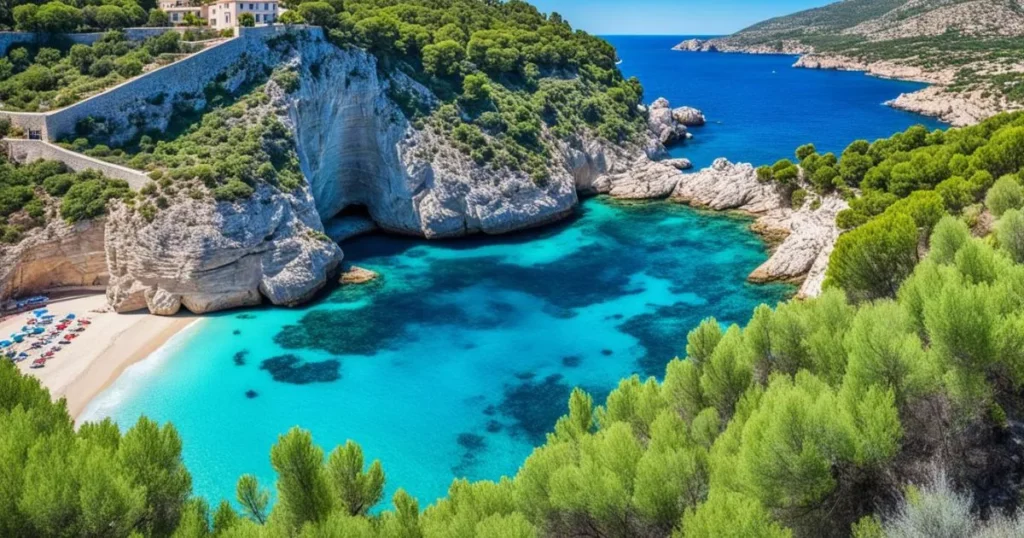
Mallorca is a unique island. It is the largest of Spain’s Balearic Islands. The island is a blend of beautiful natural landscapes, rich history, and vibrant culture. Mallorca is known for its pretty coastline. It has over 200 beaches. They range from busy resort areas to secluded coves with clear water.
Beyond its beautiful beaches, the island has dramatic mountain ranges. One example is The Serra de Tramuntana, a UNESCO World Heritage Site. It offers stunning views, charming villages, and great hiking trails. The island’s food scene is also impressive. It has local markets, traditional tapas bars, and Michelin-starred restaurants. They all showcase the flavors of Mallorcan cuisine.
Festivals and cultural events add to the island’s allure. They include the lively Sant Joan celebrations and classical music concerts in beautiful settings. Travelers seek both adventure and tranquility in Mallorca. They can explore ancient ruins, enjoy water sports, or relax in a quaint village. Mallorca’s charm and diverse offerings make it a top destination.
Overview of the Balearic Islands
The Balearic Islands are an enchanting archipelago. They are situated in the western Mediterranean Sea, off the eastern coast of Spain. The islands are famous for their stunning natural beauty, rich culture, and vibrant tourism.
The Balearics are four main islands: Mallorca, Menorca, Ibiza, and Formentera. Each island offers a unique experience. Mallorca is the largest. It is known for its diverse landscapes. These range from the dramatic Serra de Tramuntana mountains to its pristine beaches and vibrant capital, Palma de Mallorca.
Menorca is celebrated for its tranquil charm, archaeological sites, and unspoiled coastline. Ibiza is famous worldwide for its lively nightlife and electronic music. It also has beautiful beaches and a bohemian spirit. Formentera is the smallest and least developed. It is a paradise of clear turquoise waters and white sandy beaches, perfect for relaxation.
These islands are a mix of natural beauty and a rich tapestry of history, culture, and modern amenities. They make the Balearic Islands a top destination for travelers seeking adventure and peace in the Mediterranean.
The Allure of Mallorca
Mallorca’s allure comes from its mix of past and present. Its beaches and villages are perfect for relaxing explorations. But the island’s history, shown through its architecture and food, invites reflection. Their traditions blend different influences, creating a vibrant atmosphere.
When you visit, Mallorca enriches and excites your senses in the Mediterranean Sea.
| Aspect | Highlights |
|---|---|
| Natural Beauty | Serene beaches, mountainous terrains, lush landscapes |
| Historical Sites | Ancient ruins, medieval castles, charming old towns |
| Cultural Attractions | Vibrant festivals, local markets, eclectic cuisine |
| Modern Amenities | Luxury resorts, fine dining, contemporary art galleries |
Experience the Diverse Attractions of Palma de Mallorca Spain
Exploring Palma de Mallorca is like going on a journey through time. Every corner shows a new part of its history and life. It has places that interest people who love history, culture, and the sea.
Visit the Historic Bellver Castle
The historic Bellver Castle sits atop a wooded hill above Palma de Mallorca. It is a great example of Gothic military architecture. It is one of the few circular castles in Europe.

It was built in the early 14th century for King James II of Mallorca. The impressive fortress has a special design. It has a central courtyard, three large towers, and a towering keep connected by a bridge. The castle’s layout is unique and circular. Its well-preserved structure offers a fascinating glimpse into medieval engineering and defense.
Over the centuries, Bellver Castle has had many roles. It was a royal residence, a military prison, and now a museum. The museum holds the city’s historical artifacts. Visitors to the castle see stunning panoramic views of Palma, its harbor, and the countryside.
The views make it a popular spot for history buffs and photographers. The calm, forested surroundings and the castle’s grand presence combine to create a captivating destination. It vividly brings Mallorca’s storied past to life.
Discovering the Ancient Casco Antiguo
Ancient Casco Antiguo is the historic old town of Palma de Mallorca. It is a captivating labyrinth of narrow, winding streets and alleyways. They transport visitors back in time.
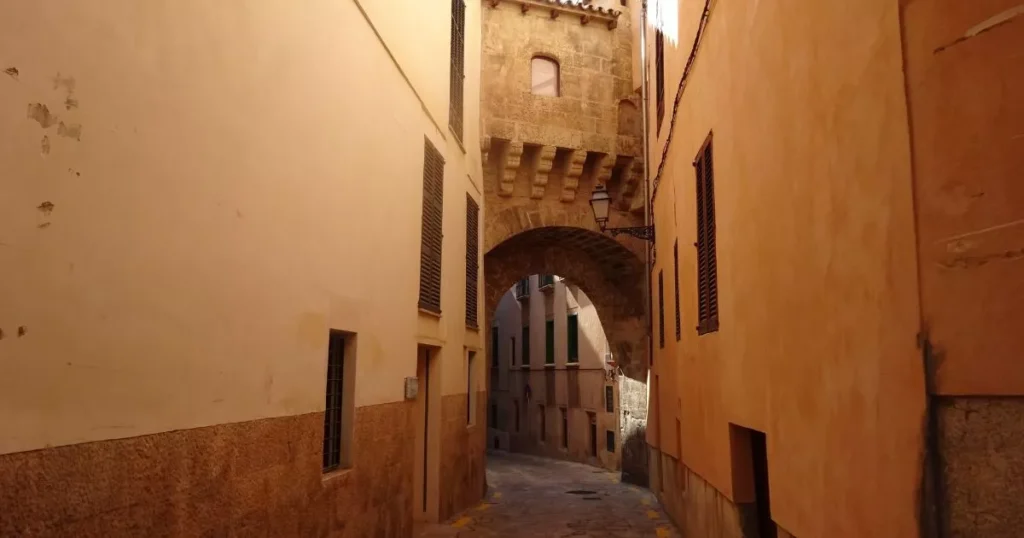
This charming district is steeped in history. It has a rich architectural heritage. It has well-preserved medieval buildings, grand Gothic churches, and elegant courtyards. The majestic La Seu Cathedral, with its soaring spires and intricate details, dominates the skyline and serves as a focal point of the old town.
Nearby, the Royal Palace of La Almudaina, originally an Arabian fort, adds to the area’s historical allure. As you wander through Casco Antiguo, you’ll encounter picturesque squares. Examples include Plaza Mayor and Plaza de Cort.
They are lined with quaint cafes, artisan shops, and bustling markets. The old town’s vibrant atmosphere is enhanced by its blend of cultural influences, reflecting centuries of Roman, Moorish, and Christian rule.
Each corner of Casco Antiguo reveals a story. It is a treasure trove for history buffs and a delightful area for leisurely exploration.
Maritime Heritage and C.S. Maritimo
Palma de Mallorca’s maritime heritage is deeply woven into the city’s history and culture. The heritage is showcased by the esteemed Club de Mar Mallorca (C.S. Maritimo). C.S. Maritimo is one of the top yacht clubs in the Mediterranean.
It plays a key role in keeping and celebrating the island’s long seafaring traditions. It was founded in 1948. Since then, the club has become a hub for sailing fans and maritime pros. It offers top-notch facilities, including a marina for some of the world’s most luxurious yachts and sailing vessels.
The club organizes many regattas and sailing events. They draw participants and spectators from around the globe. This fosters a vibrant community of people united by a passion for the sea.
The waterfront is adorned with nautical-themed landmarks and museums. For example, there is the Museo Marítimo de Mallorca. It chronicles the island’s rich maritime history through fascinating exhibits and artifacts.
The mix of historical reverence and modern nautical excellence makes C.S. Maritimo a cornerstone of Palma’s maritime identity. It highlights the enduring bond between the city and the sea.
Boat and Water Adventures
Exploring Palma de Mallorca on a boat tour is thrilling. It’s a great change from standard cruises. Whether you’re a pro or a first-timer, the island’s waters are full of surprises.
Boat Tours Around the Island
Boat tours around the island of Mallorca offer an enchanting way to see its breathtaking coast and hidden gems. These tours provide a unique view. They let visitors explore secluded coves, pristine beaches, and dramatic cliffs. These spots are often unreachable by land.
The vessels cater to different preferences and budgets. They range from luxurious yachts to traditional wooden boats. Popular destinations include the stunning Cala Figuera. Also, there are the picturesque Dragonera Island and the serene Cabrera Archipelago.
The archipelago is a national park full of wildlife and natural beauty. Many tours also offer chances for snorkeling, diving, and swimming. The water is crystal clear. It makes for an unforgettable aquatic adventure.
The boat glides along the coast. Passengers can enjoy panoramic views of historic lighthouses, charming fishing villages, and the impressive Serra de Tramuntana mountains.
Boat tours around Mallorca offer a great way to discover the island. They cater to many tastes: romance, adventure, and family fun. You can enjoy a sunset cruise, a day trip, or a family-friendly excursion. The tours show off the island’s diverse landscapes and rich maritime heritage.
Water Sports and Activities

Mallorca is a haven for water sports lovers, offering a wide array of activities to suit all interests and skill levels. The island’s beaches and coves are great for swimming, snorkeling, and scuba diving. They let adventurers explore lively marine life and caves.
Windsurfing and kitesurfing are popular on the windier parts of the coast. These include Pollensa Bay and Alcudia, where steady breezes make ideal conditions. For those seeking more excitement, jet skiing, parasailing, and wakeboarding are thrilling. They provide ways to enjoy the azure waters of the Mediterranean.
Kayaking and stand-up paddleboarding are great for exploring Mallorca’s hidden coves, rugged cliffs, and calm bays. You can go at a leisurely pace. Sailing is a big part of the island’s maritime culture. Many schools and rental services are available for both new and experienced sailors.
Mallorca offers an unmatched aquatic playground. It promises unforgettable experiences for all who visit. They can find the excitement of high-speed water sports or the peace of paddling through calm waters.
Historical Walking Tours and Day Trips
Walking around Palma de Mallorca has been an amazing journey for me. The city’s walking tours took me on a trip through its vibrant history. I learned fascinating stories from the past, right on the ancient streets and famous sites. These tours showed me the rich cultural mix of Mallorca and the interesting tales that built its history.
My top part of these tours was finding little-known places just around the corner. Whether it was old plazas or beautiful cathedrals, each had a story to tell. I loved how the tours showed the city’s history while letting me enjoy its beauty and views.
I still remember standing in awe before the grand façade of La Seu Cathedral, feeling transported back to a different era. It’s moments like these that make historical day trips in Spain truly unforgettable.
Heading out of the city, day trips broadened my view of Spain’s history. I visited charming villages, beautiful nature, and not-so-famous sites. These trips, whether to an old monastery or a local market, gave a real feel for the island’s history.
Here is a comparison of some popular Palma de Mallorca walking tours and day trips:
| Tour Name | Description | Main Attractions |
|---|---|---|
| Old Town Walking Tour | An in-depth exploration of Palma’s historic center | La Seu Cathedral, Almudaina Palace |
| Valldemossa Day Trip | Discover the charm of this picturesque village | Royal Carthusian Monastery, local markets |
| Jewish Quarter Tour | Diving into the history of Palma’s Jewish community | Calle de la Sol, ancient synagogues |
| Soller and Train Ride Excursion | A scenic journey through Mallorca’s landscapes | Vintage train ride, Soller town exploration |
Lively Markets and Shopping Districts
Exploring Palma de Mallorca’s shopping scene feels like hunting for treasure. You can find unique Spanish products and modern goods alike. It’s a place that offers many different experiences.
Local Markets and Traditional Crafts
The local markets in Palma de Mallorca sell traditional crafts. They offer a vibrant glimpse into the island’s rich cultural and artisanal heritage.
Visitors can stroll through the bustling Mercat de l’Olivar. They can immerse themselves in a feast of fresh produce, spices, and local specialties. These include cured meats, cheeses, and pastries. The market’s lively atmosphere is complemented by friendly vendors eager to share the stories behind their goods.
Beyond the food markets, Palma’s streets have shops and stalls. They showcase traditional Mallorcan crafts. They make intricate handmade ceramics. They also make delicate glassware from Gordiola. And, they make exquisite textiles, like the iconic “roba de llengües” (cloth of tongues). These items embody the island’s artisanal expertise.
The weekly market at Plaza Mayor features local artisans. They sell everything from leather goods and jewelry to wooden carvings and wrought ironworks. Each piece reflects Mallorca’s unique blend of cultures.
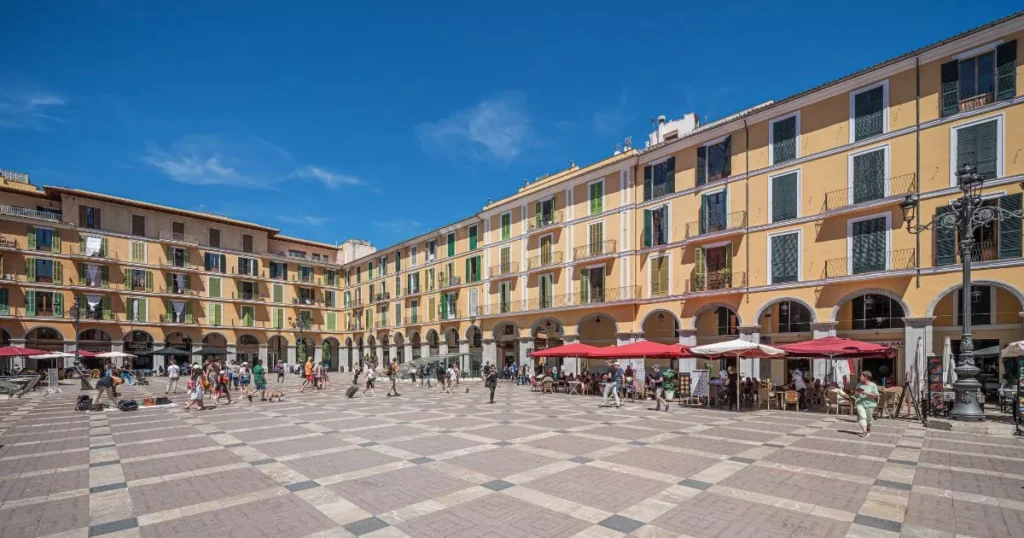
These markets and crafts provide perfect souvenirs. They also connect visitors to the island’s history and the skilled craft passed down through generations.
| Market | Highlights | Location |
|---|---|---|
| Mercat de l’Olivar | Fresh seafood, local produce | Pl. de l’Olivar, 07002 Palma |
| Mercat de Santa Catalina | Gourmet foods, crafts | Carrer de Sant Magí, 57042 |
Shopping in Contemporary Malls
Shopping in modern malls in Palma de Mallorca offers a dynamic retail experience. They blend international brands with local flair.
The city is home to many sleek shopping centers. For example, there is Porto Pi Centro Comercial. It has a wide range of stores, from high-end fashion boutiques to popular global retailers. Visitors can find everything from the latest in fashion and electronics to cosmetics and home decor, all under one roof.
FAN Mallorca Shopping is another big mall. It has an open-air design with lovely, landscaped areas. These create a nice shopping environment. It includes major brand outlets and a variety of dining options. It also has entertainment facilities like cinemas and play areas for children.
These modern malls are for all ages. They offer a convenient and fun shopping experience with lots of parking, modern features, and seasonal sales and events. You might be hunting for the latest trends. Or, you might just be enjoying a leisurely day out.
The malls in Palma de Mallorca offer a perfect mix of shopping and relaxation.
A Hub for Festivities and Events
Palma de Mallorca comes alive with its many festive events, attracting people from all over. This beautiful city by the Mediterranean Sea mixes old traditions with new vibes. It’s the perfect place for fun, from parades full of colors to amazing art displays.
Annual Festivals to Attend
Palma de Mallorca hosts many annual festivals. They celebrate the island’s rich culture, traditions, and heritage. They offer visitors an immersive experience they will not forget.
One highlight is the Fiestas de San Sebastián in January. They feature colorful processions, traditional dances, and lively street parties. The events honor the patron saint of Palma de Mallorca.
The city comes alive in February or March, depending on the date of Easter. This is during the Carnaval, a dazzling spectacle of parades, costumes, and music. It fills the streets with joy and laughter. In June, the Nit de Foc marks the beginning of summer with spectacular firework displays and bonfires that light up the night sky.
The city’s maritime heritage shines during La Diada de Mallorca in September. It’s a day-long celebration of Mallorcan culture, music, and food. The celebration ends with a grand fireworks show over the bay.
Other big festivals include the Nit de l’Art in September. It’s a showcase of modern art and culture. In December, there are the Christmas markets and festivities. The streets fill with lights and decorations, creating a magical atmosphere.
The festivals happen once a year. They offer a glimpse into the soul of Palma de Mallorca. They bring together locals and visitors in celebration and camaraderie.
Conclusion
My time in Palma de Mallorca showed me an amazing mix of history, beauty, and taste. It’s a top spot for those wanting a Mediterranean holiday. Exploring Palma meant seeing old Roman sites, Gothic buildings, and sunny beaches. I enjoyed walking through the ancient streets or trying local foods.
Palma is full of fun and beauty, making it perfect to visit again. It blends lively nights, art, and easy travel. Visiting Palma is magical. It leaves memories that will call you back to see more.
FAQ
Q: What are the top attractions in Palma de Mallorca?
A: Palma de Mallorca is famous for its stunning cathedral, the Santa Maria of Palma, a masterpiece of Gothic architecture partly designed by Antoni Gaudí. Other top attractions include the old town of Palma, with its narrow streets and historic buildings, the Palace of Almudaina, the bustling Mercat de Santa Catalina, and the chic seafront promenade. The city’s rich history, combined with its vibrant markets and beautiful beaches, makes it a must-visit destination.
Q: Why is the cathedral a must-see in Palma City?
A: The cathedral, known locally as “La Seu”, is a symbol of Palma and one of the most magnificent examples of Gothic architecture in Spain. It’s renowned for its spectacular rose window, which is one of the largest in the world, and its interior features, including work by Antoni Gaudí. Its position overlooking the bay makes it a stunning sight, especially when it’s lit up at night, reflecting off the water of the Badia de Palma.
Q: Can you recommend things to do in Palma and surrounding areas?
A: Beyond exploring the historic city of Palma, including the Cathedral and Old Town, visitors can enjoy a variety of activities around Palma de Mallorca. Taking a stroll along the Passeig del Born offers shopping and dining in a beautiful setting. Nearby, the beaches offer relaxation and water sports, with the city beach providing easy access to the sea. For a slice of local life, visit the Mercat de Santa Catalina to sample local foods. Nature enthusiasts will appreciate the natural beauty of the Serra de Tramuntana mountains, just a short drive away.
Q: What makes Palma’s Old Town unique?
A: The old town of Palma is a captivating maze of narrow streets that echo with history, unveiling the diverse cultures that have influenced Palma over the centuries, from the Moors to Catalan settlers. It hosts an array of Gothic buildings, quaint coffee shops, and hidden courtyards. Highlights include the churches of St. Francesc and St. Pere Antoni. It’s a place where one can easily lose track of time, surrounded by the rich heritage and tranquil ambiance that defines Palma’s old town.
Q: Are there any unique markets or plazas in Palma City?
A: Palma de Mallorca boasts several markets and plazas that are full of character and life. The Mercat de Santa Catalina is notable for its lively atmosphere and wide range of fresh produce, while the Plaza Mayor is the heart of the city, with its many cafes, street performers, and artisan stalls. These spots offer a glimpse into the daily lives of the residents and are perfect for those looking to experience the local culture and cuisine.
Q: What is the significance of Palma’s seafront area?
A: Palma’s seafront is one of the city’s most vibrant areas, offering breathtaking views of the Mediterranean and the city’s marina. This area is perfect for leisurely walks, cycling, or enjoying a meal in one of the many restaurants and cafes that line the promenade. The seafront is also where many of Mallorca’s luxury hotels are located, making it a central point for tourists to enjoy the best of Palma de Mallorca, from its beaches to its nightlife.
Q: How can visitors explore the coast of Mallorca from Palma?
A: From Palma, visitors can easily explore the stunning coast of Mallorca. Car rentals and public transportation offer access to the island’s extensive beaches and secluded coves. Boat trips from the Port of Palma provide a unique perspective of the island, showcasing the rugged coastline, crystal-clear waters, and hidden beaches. For the adventurous, sailing and water sports are widely available, offering a memorable experience of Mallorca’s natural beauty.
Q: What historical insights does the city of Palma offer?
A: Palma is steeped in history, having been under Moorish control before becoming the capital of the Kingdom of Mallorca. Its architecture and monuments, such as the Lonja and the old walls that once defended the city, provide insights into its past. The Cathedral and the Old Town’s narrow streets hint at the city’s medieval and Moorish past, offering a living history lesson. Palma’s museums also offer a deep dive into the island’s cultural and artistic heritage, making it a fascinating destination for history enthusiasts.

